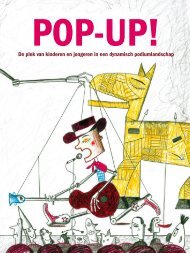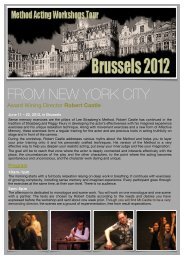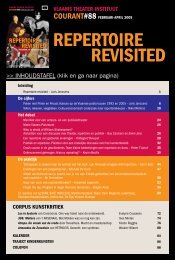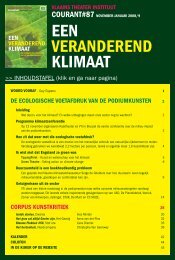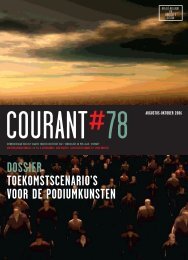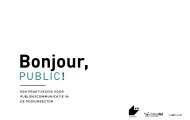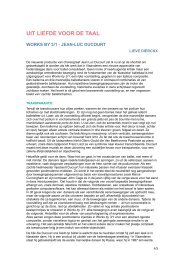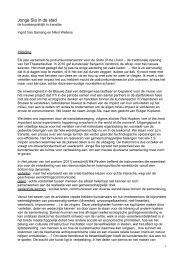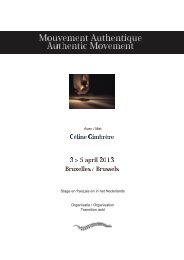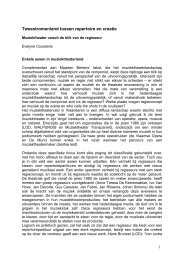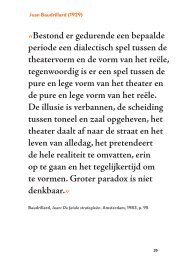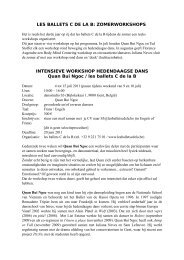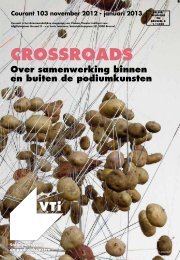You also want an ePaper? Increase the reach of your titles
YUMPU automatically turns print PDFs into web optimized ePapers that Google loves.
josse de pauw<br />
(whereby the build-up of tension focused mainly on the passage<br />
of time). In addition to these quite new (meta-theatrical) elements,<br />
there were also a considerable number of constituents<br />
from the world of cartoons (e.g. an immensely long arm that<br />
crawled over the stage) and parodic variants on variety theatre<br />
(e.g. catch and acrobatic numbers, puppet numbers, dance and<br />
music numbers). Radeis wegens ziekte was a chain of more or<br />
less separate absurdities whose main connection was the set. The<br />
agency behind all this absurdity was also written into the performance.<br />
Is it the four directors who sit in their film-set chairs at<br />
the end? Or the implacable voice that shouted where the actors<br />
had to drag parts of the scenery: ‘Attention. Position K2.<br />
Interior: upstage middle. Position K1. Interior: 30° left, position<br />
K2. Position K3. As arranged.’<br />
The next production, Ik wist niet dat Engeland zo mooi was<br />
(1979-83) was invited to the Amsterdam Festival of Fools and<br />
from there took off internationally (with an adapted title: I didn’t<br />
know the continent was so beautiful). Whereas it was hardly possible<br />
to distil any theme out of Radeis wegens ziekte, in its successor<br />
the group was more focused on a goal. This production no<br />
longer consisted of a series of numbers quite separate from each<br />
other, but was a more or less coherent whole: four holiday-makers<br />
who end up in cheerless surroundings fill it up in no time at<br />
all with things that can be used to make jokes. The piece<br />
arranged fairly classical acts as intermezzi (2 clowns, acrobats,<br />
megaphone band, etc.) in a basic structure that combined variants<br />
on variety (striptease, Hawaiian dance) with a surprising<br />
series of absurdities. There is a permanent humorous contradiction<br />
between events on stage and the very clear frame of reference<br />
(holiday-makers). In the booklet The Flemish Theatre and<br />
the work of Radeis, Carlos Tindemans described the piece as ‘A<br />
clown’s work of high level, homogeneous from concept to structure’.<br />
6 Frivolous meta-theatricality remained a trade mark of<br />
Radeis in this piece too. It was not by chance that the performance<br />
ended with several words (spoken by Josse <strong>De</strong> <strong>Pauw</strong>): ‘La<br />
mare. Teatro esperimentale’.<br />
Gag-o-matic (1979-80) was not really a theatre production, rather<br />
a sort of travelling exhibition, a peepshow, made out of the sets of<br />
the previous productions and specially intended for fairs and such-<br />
18 / Kritisch Theater Lexicon - 14 e - August 2001<br />
artistic development: de pauw’s way and weg<br />
like. The actors’ performance was reduced to minimal proportions,<br />
and in fact they became the invisible manipulators of a<br />
miniaturised theatre of objects. The spectators could peep at about<br />
fifty miniature scenes through peepholes.<br />
Radeis once more increased their dramatic unity in the last but<br />
one production Vogels [Birds] (1981-84). The successive situation<br />
sketches formed a proper mini-story with a beginning, middle<br />
and end. The acting area was filled by an immense birdcage.<br />
A small bird-being suddenly hatched from a giant egg and was<br />
soon seeking freedom. Two other birds, who had lived in the<br />
cage for some time, followed the newcomer when it escaped.<br />
After an enjoyable exploratory trip (full of nonsensical jokes)<br />
they return to the cage. The youngest bird-being has had slightly<br />
too much enjoyment from his freedom and has to be punished<br />
(by having an egg smashed on his head: another clown act).<br />
Although Radeis prided themselves on not appearing moralistic,<br />
in this case it was more difficult to ignore the direct symbolism.<br />
The synthesis of Radeis’ work and at the same time the end of its<br />
artistic career was Echafaudages (first version 1981, second<br />
1983). In the second version in particular, this piece followed a<br />
logical, coherent pattern. The group now introduced a clear<br />
social discourse, regarding the relationship between worker and<br />
machine. The action was set on a building site, near some scaffolding.<br />
Even before the working day began, the work area was<br />
brought to life by invisible hands: machines made strange<br />
sounds, a trestle went for a short walk, etc. Then the actors<br />
themselves made their entrance, as workers. The machines are<br />
caressed, lamps light up when they are stroked, a circular saw<br />
roars for its breakfast, two machines enter into a jealous duel for<br />
attention and love. After this confrontation with their equipment,<br />
the workers direct their energy at each other. In this way<br />
they escape the dreary reality in all kinds of games and fantasies.<br />
At the end the workers form a protest march with an odd solidarity,<br />
and march lame and stumbling towards the audience with<br />
the red flag raised. In this play, the act of communication with<br />
the props reaches a peak. The actors manipulated the objects in<br />
such a way that with only minuscule movements they began to<br />
lead a life of their own. All at once the smallness of the animated<br />
objects became the centre of the action.<br />
19 / Kritisch Theater Lexicon - 14 e - August 2001



